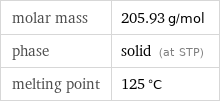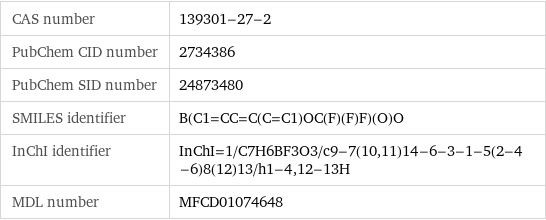Input interpretation

4-(trifluoromethoxy)phenylboronic acid
Chemical names and formulas
![formula | CF_3OC_6H_4B(OH)_2 Hill formula | C_7H_6BF_3O_3 name | 4-(trifluoromethoxy)phenylboronic acid IUPAC name | [4-(trifluoromethoxy)phenyl]boronic acid alternate names | [4-(trifluoromethoxy)phenyl]boronic acid mass fractions | B (boron) 5.25% | C (carbon) 40.8% | F (fluorine) 27.7% | H (hydrogen) 2.94% | O (oxygen) 23.3%](../image_source/878729b4d5ab2acf5e0366efd0fc4d3b.png)
formula | CF_3OC_6H_4B(OH)_2 Hill formula | C_7H_6BF_3O_3 name | 4-(trifluoromethoxy)phenylboronic acid IUPAC name | [4-(trifluoromethoxy)phenyl]boronic acid alternate names | [4-(trifluoromethoxy)phenyl]boronic acid mass fractions | B (boron) 5.25% | C (carbon) 40.8% | F (fluorine) 27.7% | H (hydrogen) 2.94% | O (oxygen) 23.3%
Lewis structure

Draw the Lewis structure of 4-(trifluoromethoxy)phenylboronic acid. Start by drawing the overall structure of the molecule, ignoring potential double and triple bonds: Count the total valence electrons of the boron (n_B, val = 3), carbon (n_C, val = 4), fluorine (n_F, val = 7), hydrogen (n_H, val = 1), and oxygen (n_O, val = 6) atoms: n_B, val + 7 n_C, val + 3 n_F, val + 6 n_H, val + 3 n_O, val = 76 Calculate the number of electrons needed to completely fill the valence shells for boron (n_B, full = 6), carbon (n_C, full = 8), fluorine (n_F, full = 8), hydrogen (n_H, full = 2), and oxygen (n_O, full = 8): n_B, full + 7 n_C, full + 3 n_F, full + 6 n_H, full + 3 n_O, full = 122 Subtracting these two numbers shows that 122 - 76 = 46 bonding electrons are needed. Each bond has two electrons, so in addition to the 20 bonds already present in the diagram add 3 bonds. To minimize formal charge carbon wants 4 bonds. Identify the atoms that want additional bonds and the number of electrons remaining on each atom: Fill in the 3 bonds by pairing electrons between adjacent highlighted atoms. Note that the six atom ring is aromatic, so that the single and double bonds may be rearranged: Answer: | |
Basic properties

molar mass | 205.93 g/mol phase | solid (at STP) melting point | 125 °C
Units

Chemical identifiers

CAS number | 139301-27-2 PubChem CID number | 2734386 PubChem SID number | 24873480 SMILES identifier | B(C1=CC=C(C=C1)OC(F)(F)F)(O)O InChI identifier | InChI=1/C7H6BF3O3/c9-7(10, 11)14-6-3-1-5(2-4-6)8(12)13/h1-4, 12-13H MDL number | MFCD01074648